Although remembered as having one of the most brilliant minds ever, Albert Einstein seemed academically slow as a child and still spoke poorly at nine years. Born into a Jewish family in Ulm, Germany on March 14, 1879, he disappointed at school, but when he was 10 years old developed a passionate interest in modern science and mathematics which was balanced by a deep love of music. In 1894, following several business failures, the Einsteins settled in Switzerland and two years later Albert entered the famous Zurich Polytechnic.

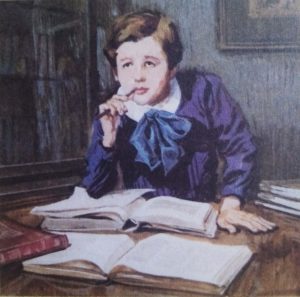
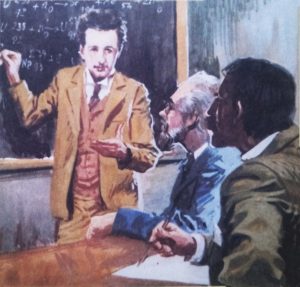
He was a gifted student and graduated in 1900 with a high-standard degree in mathematics and physics. He hoped to embark on a teaching career but no one could offer him a suitable post. In 1901 he took out Swiss citizenship and a year later found a job as a patents officer in Berne. It was interesting work but not difficult, and left him time for other studies. In 1905 he published some of the most famous papers in the history of physics, successfully challenging previous scientific laws. The scientific world now took notice of the previously obscure theorist.
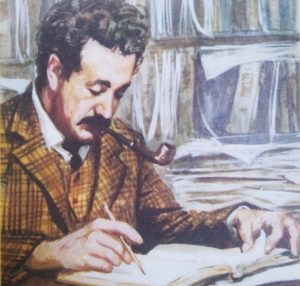
In the years following, Einstein developed and perfected his ideas and various academic positions came his way. In 1912 he became a professor at the Zurich Polytechnic and then director of the prestigious Kaiser Wilhelm Institute in Berlin. 1919 saw the publishing of his brilliant ‘Theory of General Relativity’. When its predictions were confirmed by observation of an eclipse of the Sun, Einstein became world renowned and an eagerly sought-after personality.
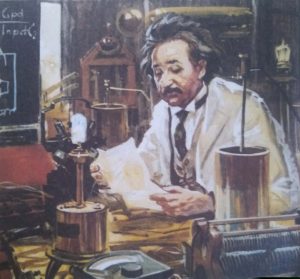
His life was transformed. In 1921 he was awarded the Nobel prize for Physics. He took visiting professorships in England and America explaining his theories and making speeches. The First World War had disturbed him greatly and his constant message was that nations should co-operate intellectually and scientifically for their mutual benefit. But the dark clouds of Fascism were gathering over Europe and Nazi Germany was no place for a Jew, not even the famous Einstein.
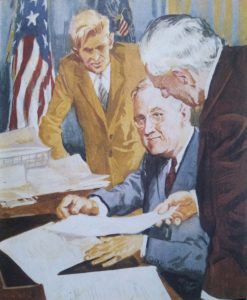
In 1933, while lecturing in America, Einstein learned that the Nazis had confiscated his property. He could not return to Germany. Instead he took a post at the Institute of Advanced Study in Princeton, New Jersey, U.S.A. When world war broke out in 1939 Einstein had to make a critical decision. His theories made possible the construction of an atomic bomb of huge destructive power. The idea of such a weapon in Nazi hands was appalling, so Einstein wrote his famous letter to President Roosevelt. As a result the ‘Manhattan Project’ was born ensuring that America produced the bomb first.

Although a pacifist, Einstein knew he had to reveal the secrets of the atomic bomb. But he was now so famous that it was very difficult for him to maintain his scientific output. Much of the war he spent helping refugees from Europe. His health was failing and he wanted peace and quiet, playing the violin and sailing his boat. Even so, he always remained humble and approachable — a shambling, good-natured genius. This century’s greatest man of science died in Princeton on April 18, 1955.
The Theory of Relativity destroys conventional ‘logical’ thinking on many subjects, but perhaps one of the most bizarre things it shows is that time itself varies. This is as difficult for us to grasp today as it was for medieval people to realize that the Earth went round the Sun.
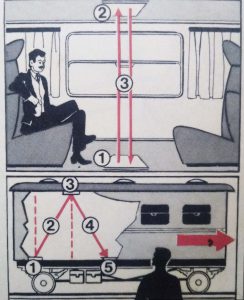
The top diagram shows a man sitting in a moving train. If he switches on a light on the floor (1), the light is then reflected by a mirror (2) back down to the floor again. We cannot see light moving, but if we could, the man would see the light go up to the ceiling and straight back down (3).
Now look at the bottom diagram. This shows what a man standing outside the train would see as it passed him by. In the time it takes for the light to go up to the ceiling and back down again the train has moved a small distance to the right, that is from 1 to 5.
So the man outside the train sees the light go from 1 to 3 to 5. And as the diagram shows, the light’s path (2 and 4) that he sees is longer than its path (3) as seen from inside the train. In the ‘same time’, the man outside has seen the light go farther than the man inside.
However, it is a fundamental law of physics that light always travels at the same speed — 299,792.458 km per second — so how can this be? There is only one answer. Time itself must vary and be relative to the two men. Because he saw the light travel farther, the man outside the train must have been there for a longer time than the man inside the train.
Of course, with trains on Earth the difference between the times inside and outside is so infinitesimal that there would be no measurable difference between the two men’s watches. In our everyday lives, time never varies.
But imagine if a spaceman set off round the Universe at a speed approaching that of light. His time is far shorter than time back on Earth. So it is possible that if he left his twin brother behind when he set off, when he got home his brother could be 20 or 30 years older than he was.
J. Robert Oppenheimer - contributions in the field of atomic energy and the Manhattan Project
Albert Einstein’s theories and discoveries in physics heavily influenced the work and contributions of J. Robert Oppenheimer in the field of atomic energy and the Manhattan Project.
Firstly, Einstein’s theory of special relativity, which he published in 1905, had a profound impact on Oppenheimer’s understanding of the physics behind nuclear reactions. This theory introduced the famous equation E=mc², which expressed the equivalence of energy and mass. Oppenheimer, like many other physicists of the time, recognized the immense energy potential contained within atomic nuclei.

In the 1930s, Einstein also collaborated with physicist Leo Szilard in writing a letter to President Roosevelt, warning him of the potential military applications of atomic energy and urging the government to initiate research in this area. This letter played a crucial role in triggering the Manhattan Project, which aimed to develop an atomic bomb.
Oppenheimer was well aware of Einstein’s letter and his concerns regarding the development of atomic weapons. As the scientific director of the Los Alamos Laboratory, Oppenheimer played a central role in the building of the atomic bomb during World War II. He deeply internalized the ethical implications of atomic energy and wrestled with the moral consequences of its use. It is said that Oppenheimer carried a copy of Einstein’s letter in his wallet, which served as a constant reminder of the gravity of his work.
Moreover, Oppenheimer was familiar with Einstein’s general theory of relativity, which he developed in 1915. Although this theory did not have immediate applications to nuclear energy, it exemplified Einstein’s revolutionary approach to physics and his ability to challenge traditional scientific understanding. This likely influenced Oppenheimer’s own approach to scientific research, encouraging him to think outside the box and explore unconventional ideas.
Einstein’s theories and discoveries, such as special relativity and his insights on the military potential of atomic energy, shaped Oppenheimer’s work and contributions in the field of atomic energy and the Manhattan Project. Einstein’s ideas provided the scientific foundation and ethical concerns that influenced Oppenheimer’s involvement in the development of atomic weapons, and they also fostered a mindset of scientific exploration and curiosity in Oppenheimer’s approach to his work.
Albert Einstein and J. Robert Oppenheimer had a complex relationship
Albert Einstein and J. Robert Oppenheimer had a complex relationship, characterized by admiration and collaboration, but also marked by differences in their approaches to nuclear physics and political ideologies.
Einstein and Oppenheimer first met in 1926 when Oppenheimer was a young physics professor at the California Institute of Technology. Einstein was impressed by Oppenheimer’s intellect and foresaw his potential as a significant figure in theoretical physics.
Their collaboration began in the late 1930s when both scientists became concerned about the rise of Nazi Germany and the possibility of Nazi scientists developing nuclear weapons. Einstein, who had famously written a letter to President Roosevelt highlighting the importance of atomic research and the potential for weaponizing nuclear energy, advocated for the formation of the Manhattan Project.
Oppenheimer, with his growing reputation as a brilliant theoretical physicist, was called upon to lead the project. Although Einstein did not directly work on the Manhattan Project, he provided crucial moral support and advice.
Einstein and Oppenheimer shared a common interest in understanding the fundamental aspects of the universe, particularly nuclear physics. However, they differed in their approaches. Einstein’s work had primarily been theoretical, while Oppenheimer was known for his expertise in experimental physics and strong organizational skills.
Despite these differences, Einstein greatly admired Oppenheimer’s abilities as a physicist and recognized the importance of his work. In a letter to President Truman after the bombings of Hiroshima and Nagasaki, Einstein referred to Oppenheimer as the “best possible man for the job” and expressed his faith in Oppenheimer’s ethical character.
Their collaboration also extended beyond their scientific endeavors. Both shared an interest in politics and were involved in social and political causes. However, their political ideologies differed. Einstein was a pacifist and a socialist, while Oppenheimer, although initially left-leaning, later became a Cold War anticommunist.
This divergence in political views strained their relationship. Einstein criticized Oppenheimer for his role in the development of nuclear weapons and the subsequent use of atomic bombs on Japanese cities. Einstein, who originally advocated for atomic research due to concern over Nazi Germany, grew increasingly skeptical and worried about the potential destructive power of nuclear weapons.
Despite their diverging ideologies, Einstein and Oppenheimer maintained a respectful relationship. They continued to correspond and exchange ideas, with Einstein valuing Oppenheimer’s intellect and contributions to theoretical physics.
Einstein and Oppenheimer had a collaborative relationship in the field of nuclear physics. They worked together indirectly through their shared interests, with Einstein providing moral support for Oppenheimer’s involvement in the Manhattan Project. However, political and philosophical differences strained their connection in later years.
Albert Einstein : A Genius
Albert Einstein was a German-born theoretical physicist who is widely regarded as one of the greatest scientific minds in history. He was born on March 14, 1879, in Ulm, in the Kingdom of Württemberg in the German Empire. Einstein’s early years were relatively ordinary, and he showed no early signs of extraordinary intellectualism. However, his curiosity and fascination with science began to emerge during his teenage years.
Einstein attended the Swiss Federal Polytechnic in Zurich, where he graduated in 1900 with a degree in physics. Despite excelling academically, he struggled to find employment initially. He eventually secured a job as a patent examiner at the Swiss Patent Office in Bern, a position that provided him with a steady income and ample time to pursue his scientific interests.
It was during this time that Einstein published several groundbreaking scientific papers that revolutionized our understanding of the physical world. In 1905, famously referred to as his “Annus Mirabilis” or “miracle year,” Einstein published four major papers that established his reputation as a scientific genius. These papers covered a wide range of topics, including the photoelectric effect, Brownian motion, special relativity, and the equivalence of energy and mass (E=mc²).
Einstein’s theory of special relativity challenged Newton’s classical physics and introduced the concept of spacetime, demonstrating that the laws of physics remain unchanged for all observers moving at constant speeds relative to one another. This radical idea had profound implications for our understanding of the universe, time, and gravity.
In 1915, Einstein extended his theory of relativity to include gravity and published his theory of general relativity. This theory proposed that gravity is not simply a force but rather a curvature of spacetime caused by the presence of mass and energy. General relativity has since been confirmed through numerous experiments and observations, cementing Einstein’s status as one of the greatest scientific thinkers.
Einstein’s work also had a significant impact on quantum physics, despite his initial skepticism of its principles. He contributed to the development of quantum mechanics through his exploration of the wave-particle duality of light and his contributions to the theory of statistical mechanics. He is particularly known for his famous quote “God does not play dice with the universe,” expressing his doubt about the probabilistic nature inherent in quantum theory.
Apart from his scientific achievements, Einstein also made notable contributions to societal and political issues. He was a vocal advocate for civil rights, pacifism, and the formation of a world government to prevent future wars. Following the rise of Nazi Germany, Einstein emigrated to the United States in 1933, where he accepted a position at the Institute for Advanced Study in Princeton, New Jersey. He became a U.S. citizen in 1940.
Einstein continued to work on various scientific problems throughout his life, but his later years were marked by a quest for a unified field theory that would merge gravity and electromagnetism. Despite not succeeding in this endeavor, his theories laid the foundation for future scientific advancements and remain fundamental pillars of modern physics.
Albert Einstein’s genius, creativity, and commitment to scientific pursuit continue to inspire generations of scientists and thinkers. His name has become synonymous with intellectual brilliance and revolutionary scientific breakthroughs. Einstein’s contributions not only transformed our understanding of the physical world but also left an indelible mark on society and the pursuit of knowledge as a whole.
Albert Einstein made several major scientific contributions that revolutionized our understanding of the universe:
-
Theory of Relativity
CopiedTheory of RelativityEinstein's theory of relativity, specifically the special theory of relativity (1905) and the general theory of relativity (1915), transformed our understanding of space, time, and gravity. The special theory of relativity, encapsulated in the famous equation E=mc², introduced the concept of energy-mass equivalence and showed that space and time are intertwined and change differently depending on the observer's relative motion.
The general theory of relativity went further by providing a new explanation of gravity, stating that it is not a force but rather the curvature of spacetime caused by mass and energy. This theory predicted the bending of light around massive objects (gravitational lensing), the existence of black holes, and the expansion of the universe.
Einstein’s theory of relativity, specifically the special theory of relativity (1905) and the general theory of relativity (1915), transformed our understanding of space, time, and gravity. The special theory of relativity, encapsulated in the famous equation E=mc², introduced the concept of energy-mass equivalence and showed that space and time are intertwined and change differently depending on the observer’s relative motion.
The general theory of relativity went further by providing a new explanation of gravity, stating that it is not a force but rather the curvature of spacetime caused by mass and energy. This theory predicted the bending of light around massive objects (gravitational lensing), the existence of black holes, and the expansion of the universe.
-
Photoelectric Effect
CopiedPhotoelectric EffectIn 1905, Einstein proposed a quantum explanation for the photoelectric effect, which showed that light can behave as both a particle (now called photons) and a wave. This work paved the way for the development of quantum mechanics, the branch of physics that describes the behavior of microscopic particles and their interactions.
In 1905, Einstein proposed a quantum explanation for the photoelectric effect, which showed that light can behave as both a particle (now called photons) and a wave. This work paved the way for the development of quantum mechanics, the branch of physics that describes the behavior of microscopic particles and their interactions.
-
Brownian Motion
CopiedBrownian MotionEinstein's 1905 paper on Brownian motion provided evidence for the existence of atoms, which had been a topic of debate for decades. By mathematically modeling the random motion of tiny particles suspended in a fluid or gas, Einstein was able to explain the irregular motion as the result of collisions with individual molecules. This work solidified the atomic theory and confirmed the existence of atoms and molecules.
Einstein’s 1905 paper on Brownian motion provided evidence for the existence of atoms, which had been a topic of debate for decades. By mathematically modeling the random motion of tiny particles suspended in a fluid or gas, Einstein was able to explain the irregular motion as the result of collisions with individual molecules. This work solidified the atomic theory and confirmed the existence of atoms and molecules.
-
The Equivalence Principle
CopiedThe Equivalence PrincipleIn 1907, Einstein proposed the equivalence principle, which states that gravity and acceleration are indistinguishable from each other. This principle laid the groundwork for the development of the general theory of relativity, connecting the effects of gravity to the geometry of spacetime.
In 1907, Einstein proposed the equivalence principle, which states that gravity and acceleration are indistinguishable from each other. This principle laid the groundwork for the development of the general theory of relativity, connecting the effects of gravity to the geometry of spacetime.
Einstein’s contributions revolutionized our understanding of the universe by fundamentally changing our conceptions of space, time, gravity, and the nature of light. His theories provided new frameworks for understanding the behavior of particles, the structure of the universe, and the interplay between mass, energy, and spacetime.
Albert Einstein's personal and academic background :
Albert Einstein’s personal and academic background had a significant impact on his scientific discoveries. As a child, Einstein was curious and displayed an exceptional ability in mathematics and physics. This early interest and talent set the foundation for his future scientific discoveries.
Einstein’s academic background also played a vital role in shaping his scientific achievements. He enrolled in the Polytechnic Institute in Zurich, where he developed a deep understanding of physics and mathematics. His professors and mentors at the Institute influenced his scientific thinking and provided him with a solid theoretical foundation.
One of the most influential factors in Einstein’s scientific breakthroughs was his unconventional thinking and willingness to question established theories. He challenged the Newtonian physics that had dominated science for centuries and introduced his revolutionary theory of relativity. Einstein’s willingness to challenge the status quo and approach problems from unique perspectives allowed him to make groundbreaking scientific discoveries.
However, despite his remarkable intellect and revolutionary ideas, Einstein faced several obstacles in gaining recognition for his work. One significant obstacle was the resistance from the scientific community. Many established physicists were skeptical of Einstein’s theories, finding them difficult to comprehend or accept. Einstein’s theories challenged long-held beliefs and required a paradigm shift in scientific thinking, making it challenging for him to gain acceptance.
Another obstacle Einstein faced was the political climate of the time. Born Jewish, Einstein faced discrimination and prejudice, particularly in Germany. Although his scientific contributions were extraordinary, the anti-Semitic sentiment pervasive in Europe hindered his career advancement. In 1933, when Adolf Hitler rose to power in Germany, Einstein was forced to flee the country for the United States, where he continued his scientific research.
Despite the challenges and obstacles he faced, Einstein’s perseverance and unwavering commitment to his scientific pursuits eventually led to widespread recognition. Today, Albert Einstein is regarded as one of the most influential scientists in history, with his theories continuing to shape our understanding of the universe.
The theory of relativity, proposed by Albert Einstein, comprises two main parts: the special theory of relativity and the general theory of relativity.
The special theory of relativity, published in 1905, introduced the idea that the laws of physics are the same for all observers in uniform motion. It revolutionized our understanding of space and time. The theory implies that the speed of light in a vacuum is constant and is the maximum speed at which information can travel.
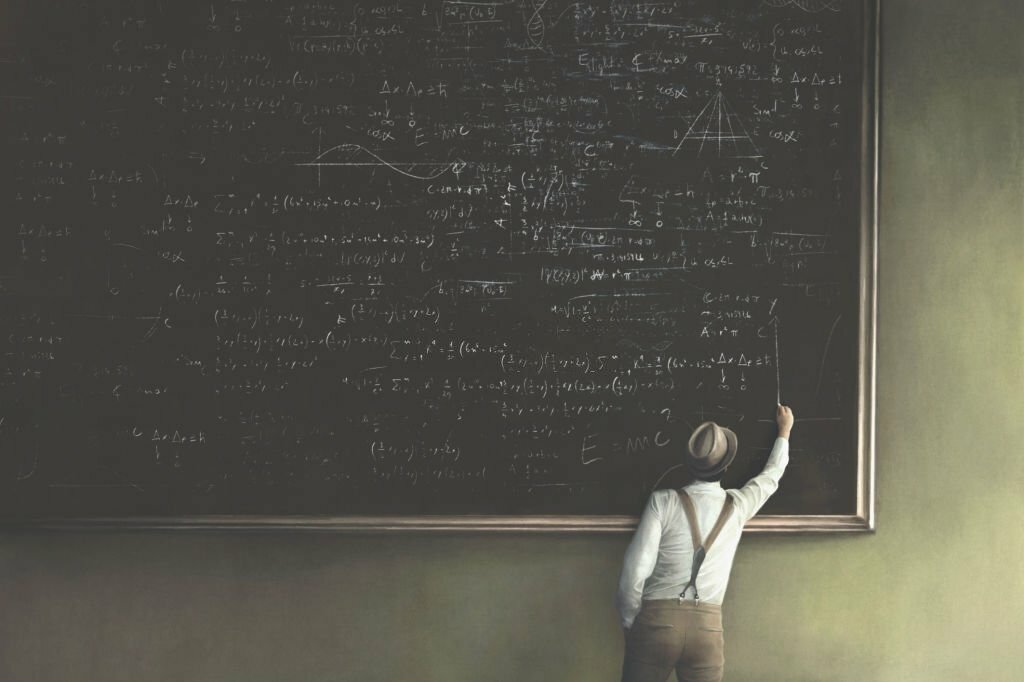
Consequently, it led to the understanding that time is not absolute but is relative to an observer’s motion. This concept is often encapsulated in Einstein’s famous equation, E = mc², which shows the equivalence of energy (E) and mass (m).
The general theory of relativity, published in 1915, extended the principles of the special theory of relativity to include gravity. According to this theory, gravity is not a force but rather arises from the curvature of spacetime caused by mass and energy. Objects move along the curved paths determined by the presence of mass, and this curvature is what we perceive as gravitational attraction. It suggests that space and time are not separate entities but are interconnected as a four-dimensional fabric known as spacetime.
The implications of the theory of relativity are profound. It challenges the classical Newtonian understanding of space, time, and gravity. Some of the key implications include:
- 1. Time dilation: Depending on an observer’s motion or proximity to a massive object, time can appear to move slower or faster. This concept has been confirmed through numerous experiments, such as the famous Hafele-Keating experiment.
- 2. Length contraction: Objects moving at high speeds appear shorter along their direction of motion. This effect becomes significant as speeds approach the speed of light.
- 3. Mass-energy equivalence: The famous equation E = mc² shows that mass can be converted into energy and vice versa. It implies that a tremendous amount of energy is contained within even a small amount of mass.
- 4. Curved spacetime and gravity: Rather than a force acting between objects, gravity is explained as the curvature of spacetime caused by mass and energy. General relativity successfully predicts phenomena like gravitational lensing and the bending of light by massive objects.
The theory of relativity has brought forth a deeper understanding of the fundamental nature of space, time, and gravity. It forms the basis of modern physics and has been extensively tested and confirmed by experiments and observations. Its implications continue to shape our understanding of the universe on both small and large scales.
Frequently Asked Questions about "Albert Einstein" :
Albert Einstein was a renowned physicist and mathematician. He was born on March 14, 1879, in Ulm, in the Kingdom of Württemberg in the German Empire. He is best known for his theory of relativity, which revolutionized our understanding of space, time, and gravity. Einstein’s achievements in physics earned him the Nobel Prize in Physics in 1921, and he is often regarded as the most influential scientist of the 20th century.
The theory of relativity, formulated by Albert Einstein, consists of two major components: the special theory of relativity and the general theory of relativity. The special theory of relativity, published by Einstein in 1905, explains the behavior of objects that are moving at speeds close to the speed of light. It introduces concepts like time dilation, length contraction, and the famous equation E=mc², which demonstrates the equivalence between energy and mass. The general theory of relativity, published in 1915, expands on the special theory and explains how gravity is not a force but a curvature of spacetime caused by massive objects.
The equation E=mc², perhaps one of the most famous equations in physics, relates energy (E) to mass (m) and the speed of light in a vacuum (c), which is a fundamental constant. This equation illustrates the concept that mass can be converted into energy, and vice versa. It showcased the potential of atomic energy and played a crucial role in the development of nuclear power and the atomic bomb.
Besides the theory of relativity, Einstein made significant contributions to several areas of physics. He conducted groundbreaking research on the photoelectric effect, which explained how light can behave as both particles and waves, eventually leading to the foundation of quantum mechanics. Additionally, Einstein developed the theory of Brownian motion, providing empirical evidence for the existence of atoms. He also made notable contributions to the field of statistical mechanics and the understanding of the bending of light by gravity.
While Einstein’s equation E=mc² made it clear that enormous amounts of energy could be released through the conversion of mass, he did not directly invent or work on the atomic bomb. However, Einstein’s letter to President Franklin D. Roosevelt in 1939 warned about the potential military use of uranium for energy and weapons, which eventually led to the Manhattan Project and the development of the atomic bomb.
Einstein’s views on religion and God were complex and often open to interpretation. Although he was raised in a Jewish family, his belief in God evolved throughout his life. Einstein described himself as agnostic, as he did not believe in a personal God who intervenes in human affairs. He often referred to his belief in a “cosmic religion” or the harmony and order present in the laws of nature.
Einstein was known for his strong pacifist beliefs and advocacy for disarmament. In 1933, he left Germany due to the rise of the Nazi regime and never returned. Einstein actively supported civil rights, the establishment of the state of Israel, and the formation of the United Nations. However, he faced criticism and persecution during the McCarthy era in the United States due to his political views.
Einstein’s genius was recognized even during his lifetime. He obtained his doctorate in physics in 1905, which is famously referred to as his “annus mirabilis.” During that year, he published four groundbreaking papers that revolutionized physics. His work gained him international recognition, and he held prestigious positions at various universities and research institutes. His ideas had a profound impact on the scientific community, leading to significant advancements in theoretical physics.
Einstein is well-known for his pithy and insightful quotes. Some of his most famous include: “Imagination is more important than knowledge,” “God does not play dice with the universe,” and “Reality is merely an illusion, albeit a very persistent one.” He had a knack for expressing complex scientific ideas in a profound yet accessible manner.
Einstein’s legacy is vast and enduring. His theories have stood the test of time and continue to shape our understanding of the universe. His work formed the basis for modern physics, from the development of nuclear power to the expansion of our knowledge of the cosmos. Furthermore, Einstein’s deep curiosity, humility, and commitment to social and political causes serve as an inspiration to many scientists and intellectuals worldwide.




























